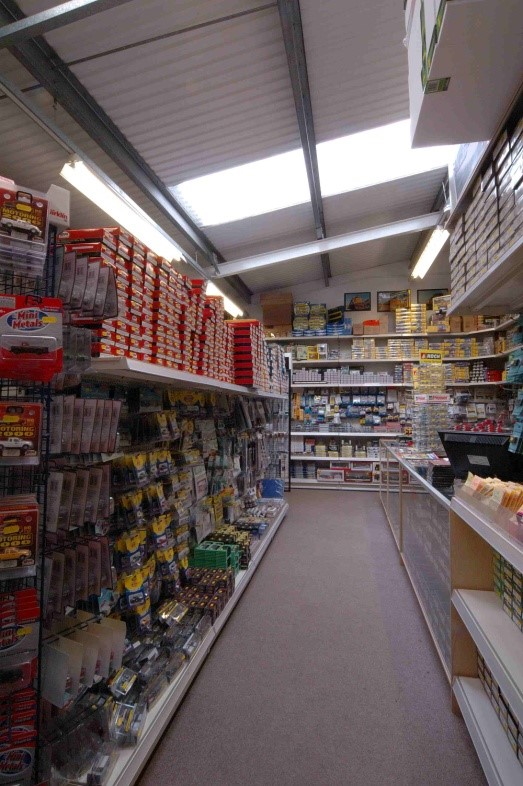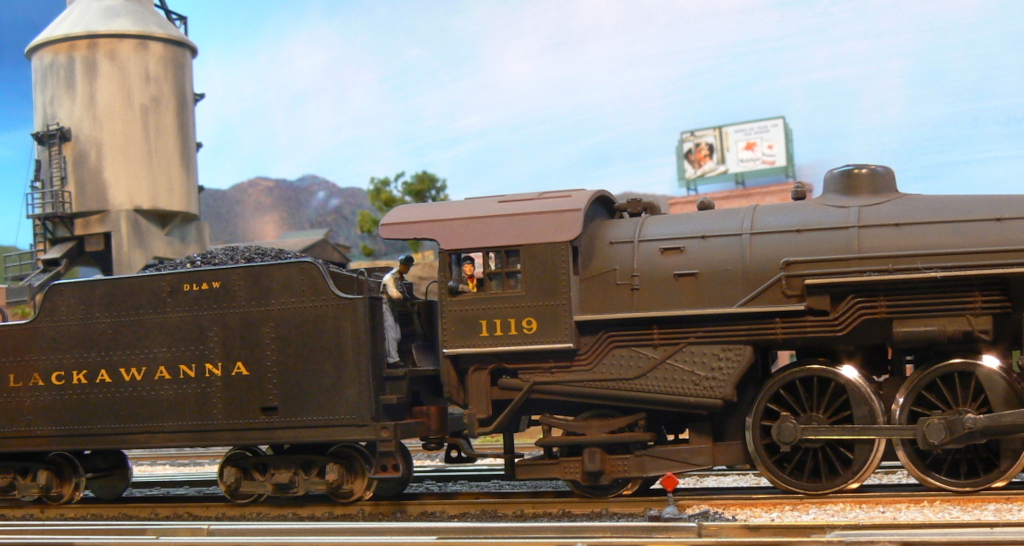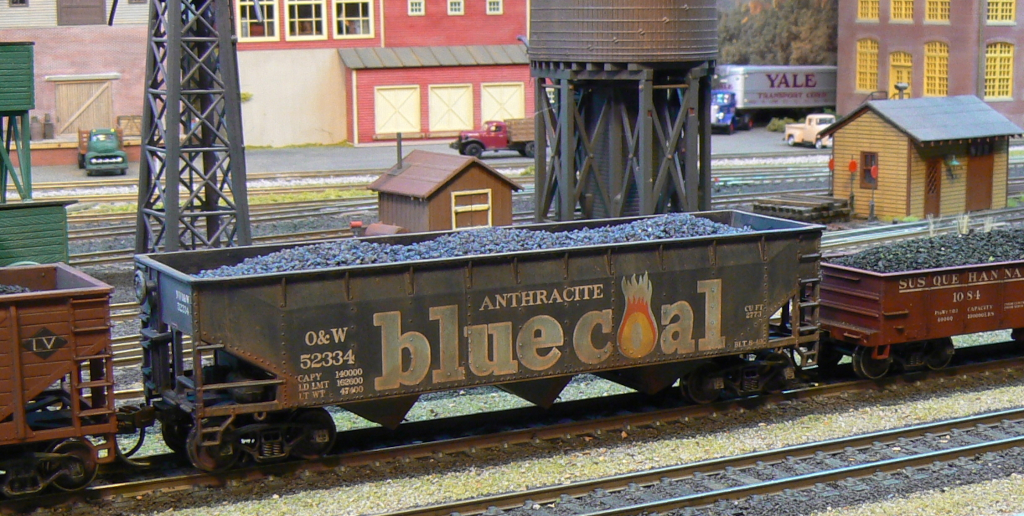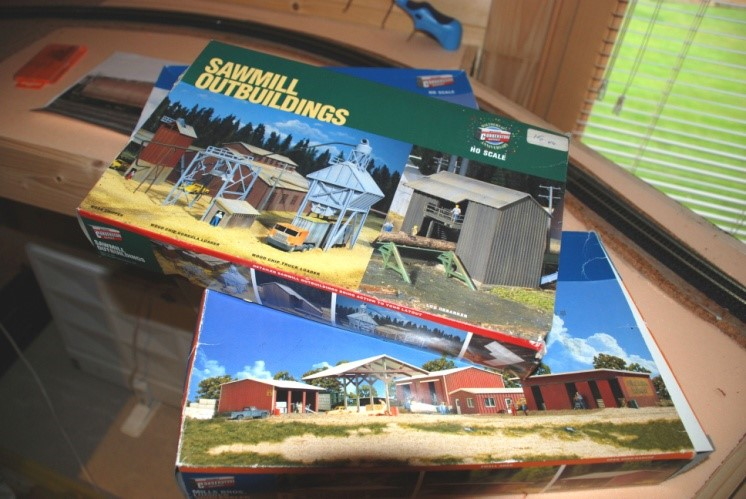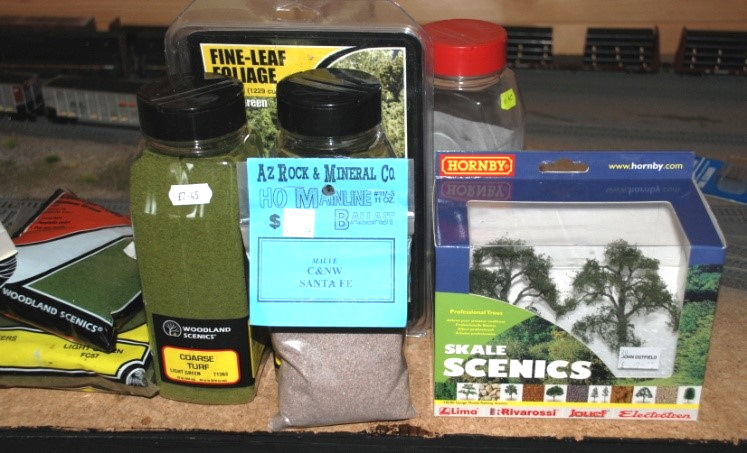Getting started – good advice for any beginner
In the Beginning
Some people get started in model railroading at a young age when a train set is received as a gift. Others get into the hobby after seeing an exhibit at a show held at a local hall or exhibition center. Some modelers focus on animation, others on scenery. Some are intrigued by railroads of a bygone era; others like to build models of the latest diesel locomotives. In the case of members in the British Region, they might have got interested in North American railroads after some years modeling British or European railroads. Whatever their interests, and however they got started, all have one thing in common — they were once beginners. And, like those who are likely to read this guide, they had questions. Some longer-standing members may still have questions.
Now that you've decided to embrace model railroading as a hobby, what's next? There is a bewildering amount of information and vocabulary to absorb and digest, both from the real world of railroads and our model trains. The number of products available in the hobby is staggering and has evolved much over the past decade or so. As you read this section of the Guide, don't assume that the content represents all the answers; this section is simply a place for you to start. And also remember, that the things written here are not cast in stone; there are as many techniques as there are hobbyists. Advice should be used as a guideline, never an absolute.
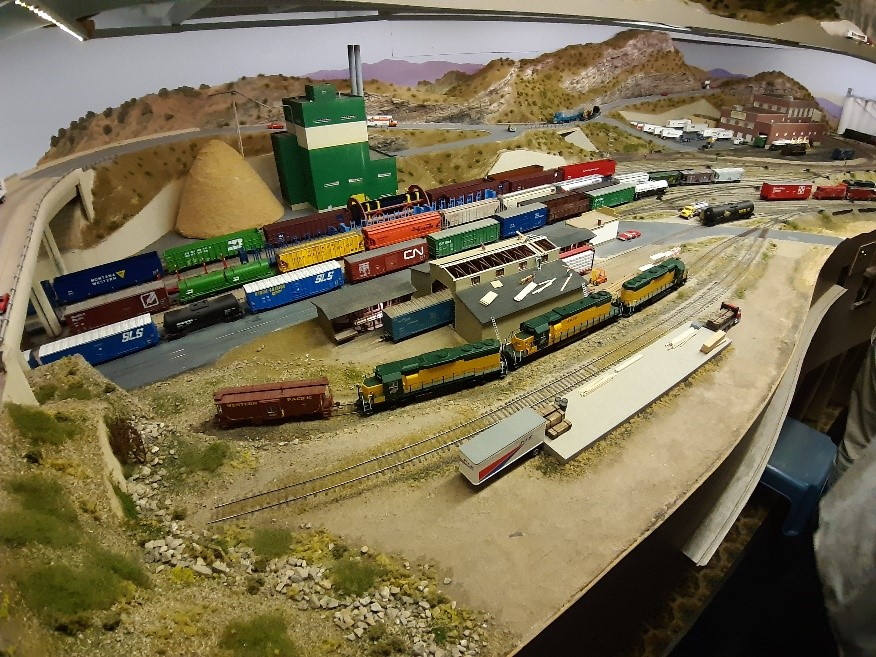
Several specific model manufacturers are discussed in this section, but there are many other fine products on the market. Don't feel limited to the products mentioned here. The brand names and products discussed will provide the beginner with a firm foundation in model railroading. Other products and manufacturers not listed will add to the pleasure of the hobby as you discover them. Seek out several opinions before plunging in.
The ultimate goal for many model railroaders is perhaps a finished, permanent layout that can be visualized as a complete miniature world. Others may want an exhibition layout or a modular setup they can take to meets and shows. As with any well-rounded hobby, one needs to learn the basics. In this age of instant gratification, a hobby like model railroading can be frustrating since everything may not come at once but is rather learned over a lifetime. This depth is what makes model railroading a lifetime hobby.
Choosing a Scale
One of the first decisions you will make is choosing a scale. Scale refers to the size of the models. Scale determines the products available, the difficulty of modeling, and how much space your model empire will require. Although there are many sizes, there are six major scales — Z, N, HO, S, O, and G (formally known as large scale). These tags are the industry-wide labels that almost all manufacturers use when describing their products.
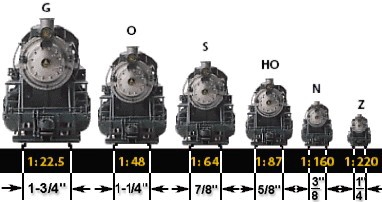
Each scale has advantages and disadvantages. There are also narrow-gauge subsets of some of these scales (see below). Z-scale is the smallest, next is N, HO, S, then comes O, and finally "Large Scale" such as G. Scale is a measure of the size of the model relative to the real thing (real trains are often called "prototype" by hobbyists). One foot in the real world equals about 1/8" in HO-scale (Half of O), which has a ratio of 1:87.1. N-scale is 1:160; S-scale is 1:64; O-scale is 1:48; and large scale (G) is 1:22.5, though this varies as there are large scale models in scales other than G. Since scale directs many of the other paths in model railroading, pick your scale carefully. (Some modelers can never decide and have chosen several scales!) If possible, visit a train show or see a modular layout set up at a meet or visit someone's layout and witness firsthand the various scales.
Since the majority of modelers are in HO, this has benefited the HO modeler with an abundance of products. Next in popularity comes N-scale, with a corresponding decrease in the variety of products. O-scale is large in size, a plus when modeling since the pieces are bigger! But there are fewer products available. Finally, G-scale has been growing in popularity. It's the only scale that can be reliably run outdoors! Many modelers choosing G-scale combine gardening with model trains, a great way to share this hobby with the rest of the family (and maybe introduce a neighbor as well). Subsequent parts of this series will look at each major scale.
One scale not mentioned much thus far is S-scale. S scale has a smaller, but dedicated group of modelers. It has fewer “off the shelf” products than some of the more popular scales and many S-scale modelers are terrific scratch builders. (Scratch building is the art of making a finished model from raw materials, instead of starting from a kit.) As a beginner, you will have to choose if this scale is for you.
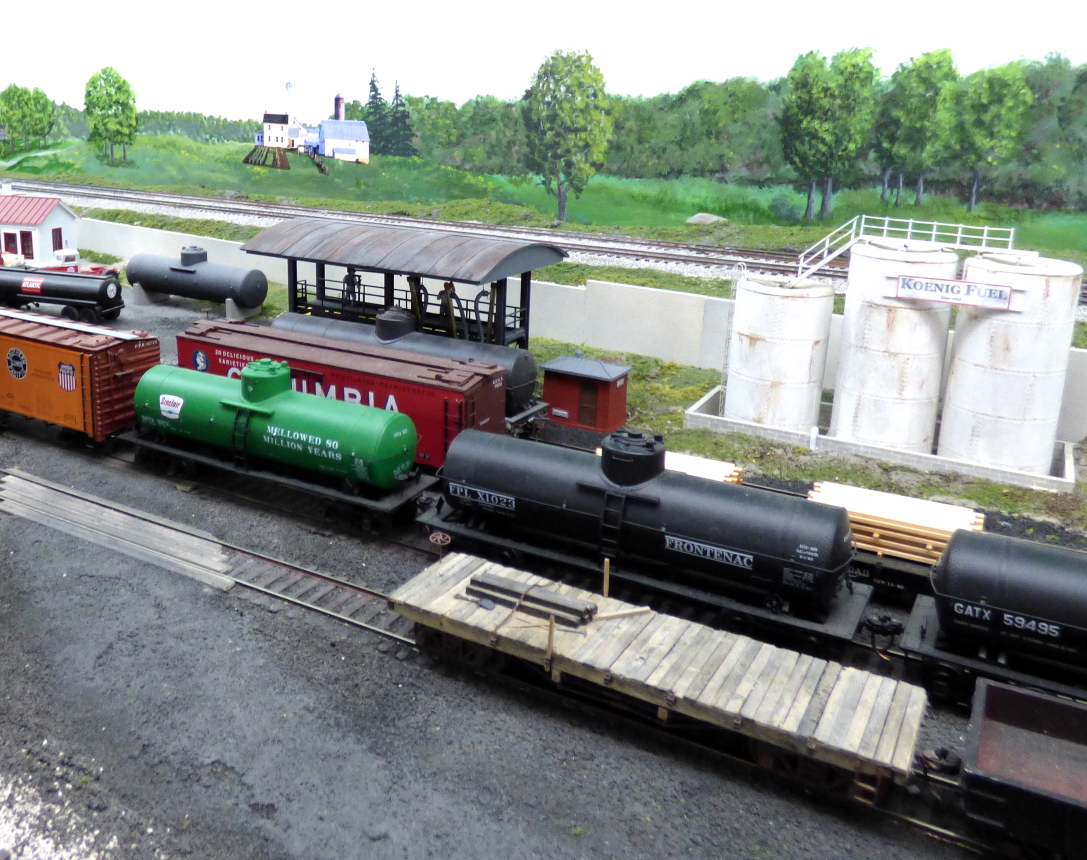
A scene from Gaylord Gill’s Buffalo & Chautaugua S-scale Railroad
You will also encounter the term "gauge" in your search for the best scale. Gauge refers to the distance between the rails. Standard gauge (4' 81/2" between the rails) is the gauge most modern prototype railroads use. If models don't mention a gauge, it is safe to assume standard gauge. The other gauge to deal with is narrow gauge. (More information on narrow gauge modeling can be found in
Part 12 of this Guide.) Typically, prototype narrow-gauge railroads used either two-foot, two-foot six, or three-foot gauge. In
model railroading, folks refer to these trains by a suffix added to the scale. For example, in HO-scale, there is HOn3 which implies a model using a three-foot spacing between the rails. HOn30 is 30 inches gauge. On30, and to a lesser extent On3, has become popular over the past decade due to increased manufacturer support. HOn3 is following a similar route. There is also Nn3 but there are few manufacturers supporting it; Sn3 is supported by specialist manufacturers – for example, see PBL at
https://www.p-b-l.com/. As you can see you can model narrow gauge in all of those scales except Z.
Eras and Equipment
Today, the serious model railroader usually chooses an era to model. Common eras are pre-1900 (the earliest days of railroading), 1901-1930 (steam engines ruled), 1931-1945 (the "golden age" of railroads), 1946-1960 (transition from steam engines to diesel), 1961-1980, and 1980s to the present (modern). As you do a little research you will eventually gravitate to an era that catches your interest. The same goes for choosing a prototype railroad to model. There were many, many railroads in the history of trains.
Searching for Information
Once a scale has been chosen, the paths in model railroading become much clearer and more defined. However, there are a number of ways in which information on what you might model can be obtained. If you have a hobby shop near you, that is a great place to start. As with all types of information, searching the Internet is also one of the first things you will want to do. Printed catalogs, like the Walthers’ Catalog, are great resources, too. If you have chosen a particular prototype railroad to model, see if they have a related historical society. They are often great sources of information as well.
Many retailers have moved to the Internet and provide online catalogs for browsing and making purchases. Retailers and manufacturers display and sell at train shows and exhibitions. These are excellent places for beginners to see products first hand. One of the largest train shows is the show held as part of the annual NMRA Convention.
Magazines are a great resource for learning and news/reviews. Included in the pages of these magazines are articles for the beginner to the advanced modeler, prototype information, and new products. Members of the NMRA can subscribe to The NMRA Magazine. The most popular commercial magazine, and good for the beginner, is Model Railroader, published by Kalmbach, which can be obtained close to the date of publication via subscription. It is also available on the shelves of many retailers, albeit about four to six weeks after publication. It can also be obtained on subscription in the UK from Bill Hudson Books of Matlock. Kalmbach offers many of their titles as an electronic download too.
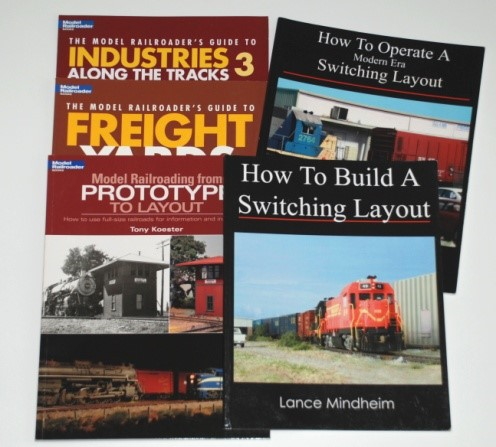
Other magazines include Railroad Model Craftsman published by White River and a free online magazine called Model Railroad Hobbyist. (See
http://model-railroad-hobbyist.com/) N-scale magazines are also available: N-Scale and N-Scale Railroading. O-scale magazines include O-Scale Railroader and O-Scale Trains. In S-scale there is The S-Scale Resource.
Magazines such as Narrow Gauge and Short Line Gazette and others have a high proportion of prototype information along with modeling articles. Finally, magazines like Trains (Kalmbach) and Railfan & Railroad (White River) deal exclusively with the real stuff. (See also trainlife.com for Pacific Rail News (1984-1996) and Rail News (1997-99).)
A word of caution: don't be depressed by the beautiful models and layouts pictured in all these magazines. These are the work of folks who have usually been in the hobby for years and have developed the necessary skills. Use the photos and modeling results as inspiration for your own efforts. You can get these results, too. Just don't be in a rush. Remember, this is a hobby, not a competition, and it should be fun.
Another excellent source of information is found in the many softcover "How-To" books. There are publications available on just about every aspect of this hobby. Many of these books are compilations of past articles printed in the monthly model railroad magazines. Some are step-by-step construction of small layouts, an excellent way to "get your feet wet" in model railroading. These project layouts are usually geared specifically for the beginner.
Track
For track, there are several options: sectional, flexible and hand-laid. Good advice is to leave hand-laid for later, as it requires some practice and patience to master. Hand laying involves purchasing rail and ties and bonding the two together using track gauges, glue, and/or spikes/solder. (See
Part 4 of this Guide for more information on laying track.)
Sectional track (or set track) is consistent but lacks flexibility. Flexible track is a good choice but takes some care to put down. Many of the project layouts use a combination of the two. Most model railroaders use nickel-silver rail in plastic ties. In HO, Atlas, Micro Engineering, Peco, Shinohara, and Walthers track products are reliable and look good. In N, Atlas, Micro Engineering, and Peco make great track. Poor track and good track poorly laid, especially turnouts (also called switches), lead to derailments and frustration. You should also note that track is sold in ‘codes’ which indicate the rail height in inches. In HO-scale, code 100 and code 83 in HO are common; in N-scale code 80 and code 55 prevail. Care should be taken not to mix them up. Micro Engineering does track in codes 83, 70 and 55! If you use say Code 83 on a main line and want to use a smaller code track on sidings or rail yards, no problem. Adapting rail joiners can be bought to ensure a smooth transition between different code track.
Regardless of the manufacturer, regular cleaning of rails is essential. Do not use steel wool or sandpaper. For oxidation (and scenery spills), use a solid cleaning block. Life-Like, Peco and Walthers make good track rubbers. Although more expensive, Atlas and Centerline Products make excellent track cleaning cars in a variety of scales and gauges. These are a great choice for larger model railroads. Alternatively, and this is the best practice as some of the above have a degree of abrasive, use cleaning fluid rubbed on using a fine cloth – no abrasions and thus no dirt traps! A low-pressure vacuum will not go amiss either. Wheels on locomotives and cars will also need to be cleaned occasionally. It is also recommended that you use metal wheels on all freight and passenger cars as plastic wheels not only attract dirt through static electricity but also deposit plastic on the railhead over time.
Power Supplies
Without proper control, our trains remain static displays. Almost all model trains today run on 12-volt DC power. This is provided by a transformer or power pack that reduces the AC voltage in your home. Like motive power, cheap power packs do not perform well and lead to frustration. Power packs come in different forms: integrated transformer and controller; separate transformers and controllers; handset controllers and plug-in panels etc. A visit to your local hobby store or careful online research is essential to see what meets your needs and your wallet.
You might also consider going straight into DCC (digital command control) where you drive each locomotive independently. (See
Part 5 of this Guide for more information on adding power to your model railroad.) Since this involves a significant investment, not only in the control system but also decoders to fit into locomotives, guidance should be sought from fellow members in your area and of course the local hobby store if they supply DCC. Like rolling stock and locomotives, there are various suppliers of DCC products. Whilst many will carry NMRA conformity certificates you cannot use all products across manufacturers – generally, you have to opt for one manufacturer’s control equipment including all handsets but they should be able to operate all locomotives regardless of whose decoder is installed – there can be exceptions but again take advice from fellow members. Each will have their own preference.
Locomotives
Your motive power (locomotive) is one of the most important pieces of equipment you will buy. Without it, your trains won't move. It should run smoothly, get good pickup from the rails and have a good finish. For HO-scale and N-scale diesels, engines by Athearn, Atlas, Bachmann, Bowser, Kato, and Walthers fill the requirements. There are many other makers of motive power, so it is always best to test-run any locomotive before purchase.
Steam engine enthusiasts, as opposed to diesel enthusiasts, must choose their motive power carefully, as the complex mechanisms of a steam locomotive can be finicky. If you choose a steam locomotive, be sure it runs well and compare it to others before buying.
If that choice was not hard enough, you also need to be aware that most model locomotives manufactured today are sold with the option of DCC-ready or DCC-equipped. The DCC-ready locomotives will run on DC track but easily accept DCC components. If you want to run locomotives with sound, DCC is your best option but some manufacturers’ locomotives run with sound, albeit a little limited, in analog or DC mode. Again, seek guidance at your local hobby store or from fellow members before you commit to buying. (
Part 8 of this Guide has a greater focus on Motive Power.)
Rolling Stock
There has been a revolution in the way rolling stock is now offered for sale. Fifteen years ago, all HO stock was in kit form, either “shake the box” kits, with just a few details to add, or craftsman kits where all parts require assembly and a higher degree of skill is needed. Today virtually all rolling stock in all the popular gauges/scales is offered in “ready to roll” (R-T-R) form. Indeed, there is a wide degree of quality within that also with at one end fairly basic and robust freight cars and at the other end far more detailed and delicate models that resemble competition standard cars. You can even obtain R-T-R freight car models in narrow gauge today!
HO manufacturers include Accurail, Athearn, Atlas, Bowser, Exactrail, Intermountain, Kato, Tangent, and Walthers. In N -cale you have Athearn, Atlas, Bowser, Intermountain, Kato, Con-Cor, and MicroTrains. There are other manufacturers but these are the main ones. Some kits are still available, usually from manufacturers who produce more obscure or specialized cars.
These still require a higher degree of skill to assemble. Passenger cars are not forgotten with many quality products available from manufacturers such as Athearn, Rapido, and Walthers – the latter even produces complete trains on an annual basis as a theme for the year.
For both rolling stock and motive power, it is good advice to look closely at the couplers that come with the kit or R-T-R product. Almost all HO-scale model railroaders use a "Kadee-equivalent" coupler that looks like prototype couplers. Most manufacturers now supply them, or an equivalent, as standard. Kadee also makes couplers in almost every scale and gauge, from N to G, but they are not used as universally in other scales as they are in HO. By following the directions, it is easy to replace the kit-supplied coupler. These Kadee couplers work consistently, provide for easy uncoupling, and are much more realistic. MicroTrains supply a similar coupler to the Kadee in N scale which is proving very popular.
To further improve the operation of rolling stock and locos, learn how to gauge the wheels with an NMRA standards gauge.
Consider using a Kadee coupler height gauge to set the correct elevation of each coupler, too.
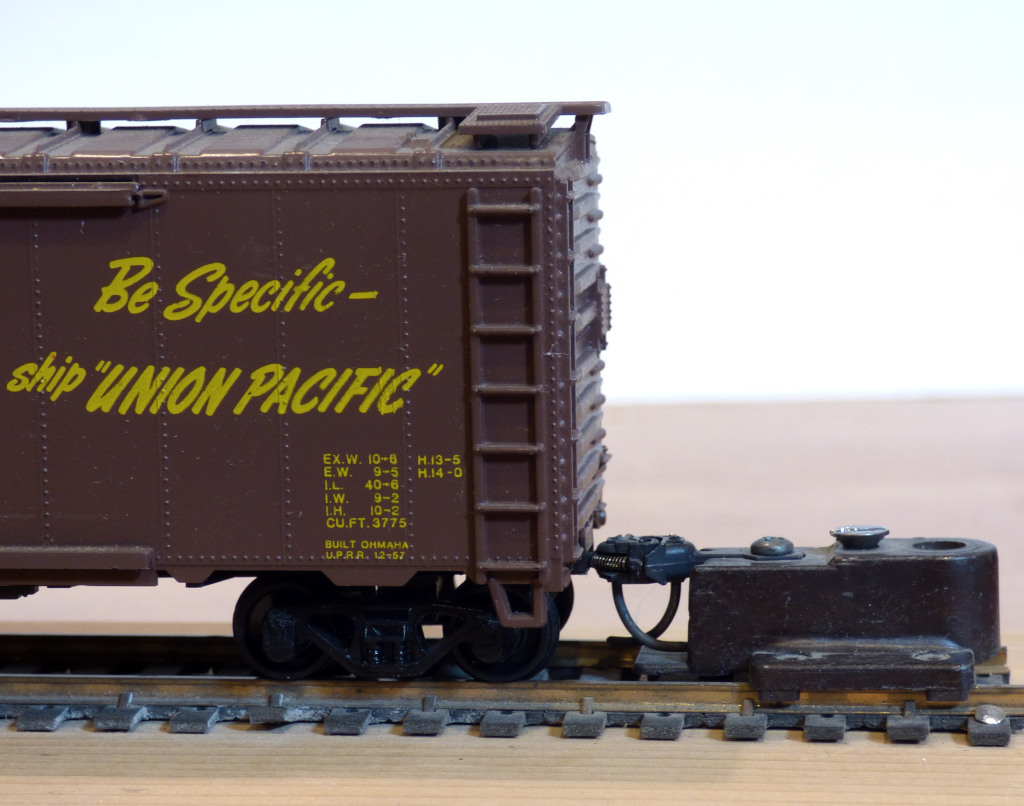 Photo: Testing the coupler height on a boxcar using the Kadee gauge.
Photo: Testing the coupler height on a boxcar using the Kadee gauge.
Again, enlist fellow modelers for this. (More information on rolling stock can be found in
Part 8 of this Guide.)
Buildings
Structure kits are as varied as the modelers that buy them. Materials encountered in most kits include plastic, wood, some metal, and plaster. Most advanced kits have a combination of materials.
Start with easy-to-build plastic structures. Wood kits are usually more difficult to construct and finish. In both HO and N, Walthers makes many fine plastic buildings. Design Preservation Models (DPM), Smalltown, and PikeStuff also produce easy-to-build, good-looking plastic buildings in several scales. Leave "craftsman" kits alone until you are confident of your skills. Choose buildings that appeal to you. That said, you can also buy some buildings made up from Walthers and Woodland Scenics, for example. (A more complete discussion of Structures can be found in
Part 7 of this Guide.)
Scenery
Scenery is one area where the beginner can almost count on to be bullet-proof. By using the traditional methods of plaster and ground foam as discussed in many of the how-to books and videos, you can make excellent scenery. Woodland Scenics makes a full line of easy-to-use materials for scenery. You will find Woodland Scenics in many model and hobby shops. Other suppliers include Scenic Express and Arizona Rock & Mineral. Browse stands at shows and meets to get an idea of what is available. Natural materials such as dirt and weeds can also be used quite effectively. If you use dirt, sterilize it first by baking in an oven!
Scale trees can be purchased or made as desired. Ready-made trees and materials for making trees are available from many vendors. One big advantage of N-scale is that scenery can be made to dwarf the trains. Scenery in the larger scales takes a lot of room. Real plants and water can be used for outdoor, G-scale railroads.
Since scenery is one area that most model railroaders have to scratch build, scenery can appear to be intimidating. Don't let it be. If your scenery is not quite right, bash it out and start over since the materials are not expensive. Remember, scenery is the stage on which your trains perform. (
Part 6 of this Guide is dedicated to Scenery.)
Tools
A craftsman is as good as his tools. In model railroading, tools can help you in many ways. Your tool chest will grow as your experience grows. A basic toolset for the beginner should include needle-nose pliers, tweezers, several sizes of small paintbrushes, clamps, a hobby knife (such as X-Acto or scalpel), small files, rubber bands, and small screwdrivers in several sizes. Larger tools should include a quarter-inch drill, a soldering iron, and a jigsaw. (
Part 11 of this Guide covers a wide range of useful modeling tools.)
Adhesives include plastic solvent glue, cyanoacrylate glue (super glue), white glue, and epoxy. Acrylic-based model paints such Testors' Accuflex and Badger Modelflex clean up with water and are non-flammable. Scalecoat and Tru-Color are solvent-based. You should consider a permanent workbench that can be left undisturbed while adhesives and paint dry. The dining room or kitchen table isn't a good location.
Putting It All Together
The goal for most model railroaders is a layout. Track, motive power, rolling stock, structures, power pack, and scenery all combine as actors in our stage play, the layout. Whether you envision an oval of track, a switching layout, or an empire, you need a plan. Layout planning will be covered in
Part 2 of this Guide. The best advice for beginners is to start small and be willing to discard initial layouts. Don't be afraid to make mistakes. A 4x8-foot layout or an 8x2 modular setup is a good size to start with in HO- and N-scales. You can build a bigger model railroad later. (
Part 3 of this Guide describes ways to build the foundation for a layout: benchwork.)
Practice all the model railroad techniques like benchwork construction, wiring, kit building, and scenery on this small layout. Temporary layouts set up on carpet usually don't work well. Another way to learn is to join a group or club that has a layout in your chosen scale. There will probably be experts available that will teach you model railroad basics using a hands-on approach. Don't be shy, introduce yourself, and learn from the group's members.
How you plan and then build your layout determines, and can be determined by, how you want to run your layout. Do you primarily want to run complete trains through beautiful scenery or do you want to do a lot of switching? Are you interested in simulating prototype railroad operations? (
Part 9 of this Guide offers options and suggestions for different ways to operate your model railroad.)
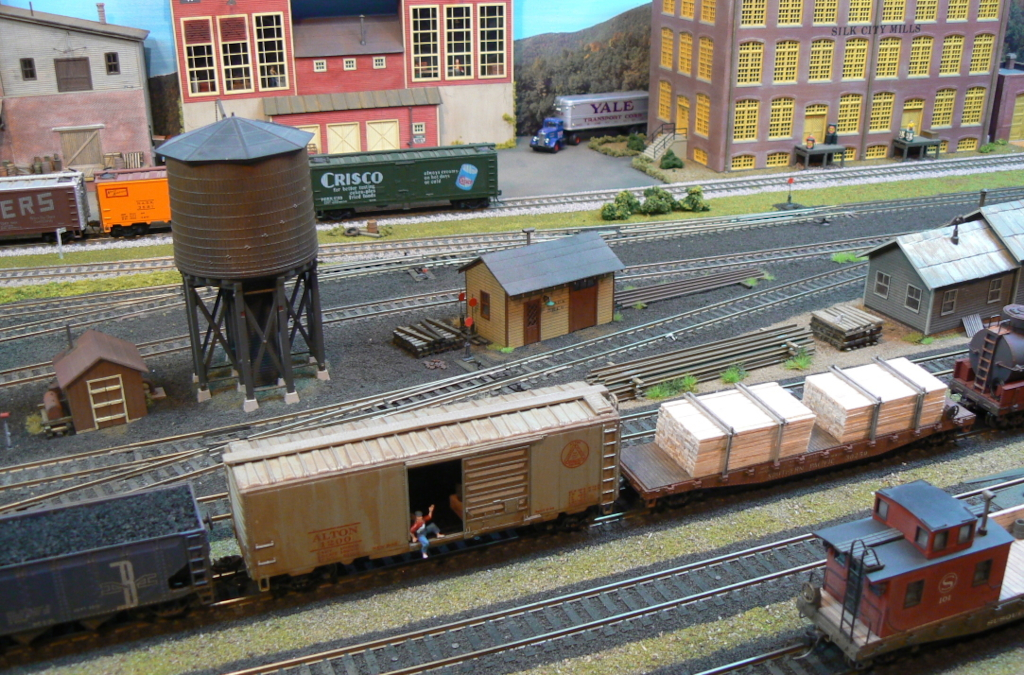 Putting it all together – a scene on Bruce DeYoung’s Jersey Highlands Railroad
Putting it all together – a scene on Bruce DeYoung’s Jersey Highlands Railroad
Another popular method to learn model railroading is to construct a module in your chosen scale. This has become quite popular over the last twenty years, and many NMRA Divisions have modular groups. With modules, each member owns their small section of railroad with standard interfaces. These are assembled together with others to make a finished layout. Modules enable a modeler to try techniques and learn on a small "layout" before attempting a more permanent layout.
With a few recommended practices, some "good advice," patience, and a willingness to learn, the beginning model railroader can have fun in a lifetime hobby. And, the NMRA will be beside you helping with standards, expertise, and resources. The best part is being united with other like-minded individuals dedicated to expanding the fine hobby of model railroading. Remember they started just where you are today.
Welcome aboard!
Credits
[Editor’s Note: This part is based very closely on an article by Doug Geiger MMR (NMRA Rocky Mountain Region) published in the July 1996 NMRA Bulletin and is reproduced and updated with his kind permission.]


